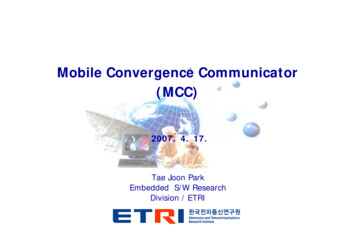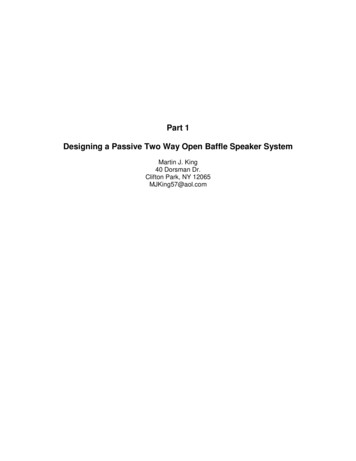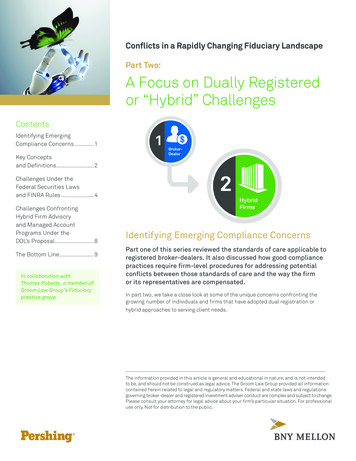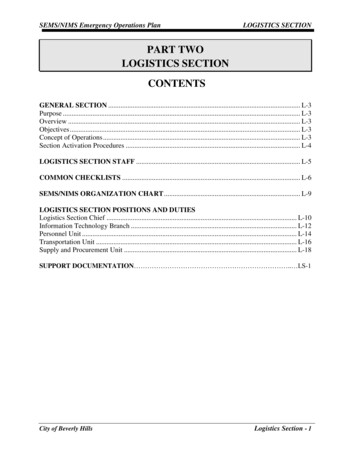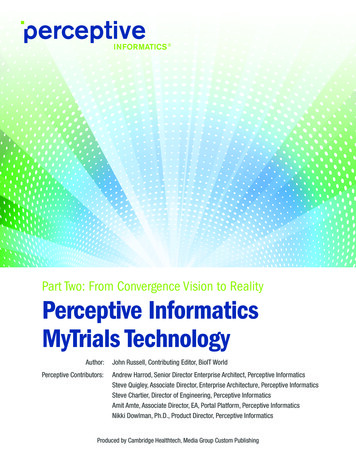
Transcription
Part Two: From Convergence Vision to RealityPerceptive InformaticsMyTrials TechnologyAuthor:Perceptive Contributors:John Russell, Contributing Editor, BioIT WorldAndrew Harrod, Senior Director Enterprise Architect, Perceptive InformaticsSteve Quigley, Associate Director, Enterprise Architecture, Perceptive InformaticsSteve Chartier, Director of Engineering, Perceptive InformaticsAmit Amte, Associate Director, EA, Portal Platform, Perceptive InformaticsNikki Dowlman, Ph.D., Product Director, Perceptive InformaticsProduced by Cambridge Healthtech, Media Group Custom Publishing
“Effective use of converged eClinical technology to deliver scientific andbusiness objectives is the cornerstone on which Perceptive’s MyTrialseClinical platform is built. All other choices – underlying IT architecture,vendor selection, optimizing the user experience – were informed by thiscentral premise.”– Bill Byrom, Ph.D., Senior Director of Product Strategy, Perceptive Informatics.It’s become quite clear that convergence is the engine for the nextgeneration of eClinical platforms. Simply assembling point tools(RTSM, CTMS, EDC, etc.) and enabling them to share data – albeitan important earlier advance – isn’t sufficient. What’s needed isa unifying architecture that blurs lines between ‘functionalities’,leverages an integrated data structure, enriches the userexperience, and, importantly, plays nicely with external tools andpartnersi (see Part One: Taming Technology Chaos - PerceptiveInformatics’ Vision of eClinical’s Future).Delivering this ambitious vision isn’t a trivial exercise. Consider theclinical data management challenge associated with just one studyhandled by Perceptive MyTrials: it had three arms, 1,236 subjects,2,066 disposition events, 679 adverse events, 92,603 concomitantmedication doses, 73,723 exposure interventions, 10,605 drugaccountability issues, 11,080 medical comments, 265,687 ECGtests, and overall 1,015, 684 medical measurements.ii That’s justthe clinical data.To cope with trials’ increasingly complicated workload, the MyTrialsenvironment was carefully built using robust technology fromindustry-leading vendors such as IBM, Informatica, InformationBuilders, and TIBCO. “A key point is the confidence we have in thetechnology and vendors used in MyTrials and that clients can alsoshare that confidence. Our approach is to seek out best-of-breed,proven vendors and form long-term partnerships. Everything is forthe long term; nothing is short term. Picking our technology is asafe bet as well as being advanced,” says Andrew Harrod, SeniorDirector Enterprise Architect, Perceptive Informatics.A detailed discussion of the technology used in Perceptive MyTrialsis beyond the reach of a short paper, but a substantive overviewis instructive. MyTrials is SaaS delivered and based on a federatedarchitecture that emphasizes standards (XML, SAML, BRIDG,etc.) where practical, openness for third-party integration, datavirtualization techniques that minimize data movement and speedperformance, and agile development techniques to accommodaterapid change.2ServicesHostingMyTrials AccessSingle sign TSMMedicalImagingMetrics yIdentityManagementAccessFederationPlatformThe core MyTrials infrastructure elements include: Clinical Technology Integration Platform Enterprise Portal Technology Enterprise Reporting Capability Identity Management Perceptive eClinical Applications (including CTMS, EDC, RTSM,ePRO, Medical Imaging)These building blocks form the basis for the MyTrials environment.SaaS delivery dramatically reduces deployment and support issuesand permits users to leverage the full capability of MyTrials corecomponents. The unified architecture also delivers a common lookand feel for users and smooth transition between workflows fordifferent roles.Part One: Taming Technology Chaos Perceptive Informatics’ Vision of eClinical’s Future;iPerceptive Informatics White PaperInformaticaWorld 2013 presentation, Perceptive Informaticsii
THE CTIP IS FOUNDATIONALThink of the Clinical Technology Integration Platform (CTIP) as a software hub that sits between otherapplications, serving as a central platform that facilitates and manages all interactions betweenmultiple technology systems. Developed using industry-leading integration and Extract Transform Load(ETL) software, CTIP delivers integration services necessary to ensure easy, robust integration acrossPerceptive’s product suite as well as the ability to integrate effectively with external applications.Besides acting as an overall controller, the CTIP catalogs the data each systems contains, keepstrack of data each system needs, and maintains a full audit trail and an activity monitor. Unlike othersolutions in which vertical tools have multiple connections to other systems, in MyTrials individualapplications have just one connection to the CTIP. This approach achieves the same data integration aspoint-to-point integrations, but does so in a more scalable and supportable manner.“We’ve taken base products from leading vendors and extended the pallets within themwith re-usable software assemblies; this allows us to deliver configurable interfaces inmany cases as opposed to having to build new every time,” says Steve Quigley, AssociateDirector, Enterprise Architecture, Perceptive Informatics. Understanding technologytradeoffs and vendor strengths also informed the CTIP development process.“While TIBCO and Informatica technically overlap and duplicate some features, they have differentbackgrounds. TIBCO’s heritage is from real-time event driven integration and Informatica is fromETL. We use the best of each. Overall they give us a very flexible technical toolkit that enables us tointegrate anything,” says Quigley. Notably, Perceptive was named Informatica’s 2012 OEM Partnerof the Yeariii for Perceptive’s expertise and effective use of Informatica data integration technology inbuilding MyTrials.Data flow and data models were key considerations in designing the CTIP. “We value not copying thedata as a principle; it should be moved only when meaningful to do so,” says Steve Chartier, Director ofEngineering, Perceptive Informatics. “Data are always in the authoritative system and additionally datais combined into our clinical data metrics mart for reporting and visualization purposes.”To a considerable extent, minimizing data movement – thus reducing associated overhead andversioning problems – is accomplished using data virtualization and semantically defined datamarts.Overall, a Publish & Subscribe dataflow (built with TIBCO technology) is deployed.“Our ETL is quite clever,” says Chartier. “We have developed an extensibility model with interfacesbased upon our information model and depending upon the genre of services that feed the informationmodel. For example, we have the notion of a CTMS (Clinical Trials Management System) defined asa semantic interface within our ETL. This idea of having an interface at the level of common clinicalservices allows us to plumb in multiple kinds of CTMS systems very rapidly.”Perceptive Informatics Namediii2012 “OEM Partner of the Year” byInformatica; view here3Among other things, the information model/ETL strategy produces higher performing systems.Consequently, Perceptive is able to deliver high SLA adherence, data freshness and data agility. “Thisis unique to Perceptive. We can take data from transactional systems, from hundreds of clinical trials,and combine that data and bring it into a presentation format in an hour or less. That’s different fromtraditional efforts, which usually go into data warehouses and rely on overnight processes,” notesChartier.
CLIENT INTEGRATION, DATAFRESHNESS,& AGILE DEVELOPMENTA use case helps illustrate data flow. In the process of a patientvisit, a site worker might log into the EDC (Electronic Data Capture)system to input data, perhaps the patient’s blood pressure. Thatdata, now in the EDC, is immediately available to other clinicalsystems. The RTSM (Randomization and Trial Supply Management)system might, for example, request the data and decide thatbased on the new blood pressure the patient’s medication dosageshould be titrated up. The system might indicate medication packA7 instead of A8 (to maintain required clinical blinding) shouldtherefore be administered at the visit.The key takeaway: Trial activities (patient visit, medicationdispensing, etc.) occur at the site. The data input, datamanagement, and system response are via web services. Adecisive enabler is that the data put into the EDC is immediatelyavailable to other clinical systems.Next, data is going to be extracted from the EDC system andbrought into the Clinical Metrics Data Mart – this happens withinan hour of data input to the EDC as scheduled workflows querythe EDC system and bring the data first into a staging area,the Operational Data Mart (ODM). Hourly the data in ODM arecombined and brought into the Clinical Metrics Data Mart (CMDM).An important point is the ODM is separate from the CMDMand the data it contains can be transformed into standard orclient specific extracts. This process enables Perceptive toSource SystemExtract4Data StagingExtractExtractDesign Goals Staging Integrity Consistency“We understand people need data in different consumptionformats and to the extent the data can stay within MyTrials we willpresent new semantic definition to the data. That happens todaywhere the customer might interact with the data in their EDCsystems through a semantic interface we’ve designed. But we canalso supply data in their preferred formats. We would never tell aclient he must get rid of one of his systems,” says Chartier.Given the inevitable changes in trial requirements and the steadyadvance of clinical technology, Perceptive has embraced AgileSoftware Development to rapidly capture change. Datamarts and theirassociated ETL are updated quarterly in accordance with Perceptive’sMyTrials extensive product roadmap. It’s worth noting that everytime a new clinical fact needs to be created, the data model must beenhanced from getting the data from its source system, to updatingtechnical specs, and generating ETL definitions.The whole process is lean. “In any particular sprint, which for us is atwo-week cycle, we might add 8 or 10 facts, and there might be 10or 20 data elements within each fact. So we might add 100 or 200elements of clinical information within a two-week cycle. That includesconceiving it, implementing it, and testing it. So our embracing ofagile allows us to enrich our clinical model with information in thetransactional systems incredibly quickly,” says Chartier.AccessData PresentationAd hoc Query toolsServices: ETL Maintain Dimensionsand facts No User queryData Sources Flat Files Relation Databases XMLprovide comprehensive clinical data generated by best-of-breedtransactional systems and flowing through b2b interfaces toclients. They in turn bring that data into their internal data hubsand feed downstream analytic systems that they’ve chosen to hostthemselves; this critical capability reflects the reality of installedsystems at clients and the need to integrate with clients’ systems.Business-ProcessesCentericLoadData Stores: ConformedDimensions Transaction Facts Snapshot Facts Accumulating FactsDesign Goals: Ease-of-use PerformanceReport WritersAnalytic ApplicationsAccessModeling: Forecasting Scoring Data Mining
ROBUST IDENTITYMANAGEMENT ISINDISPENSIBLEMultiple logon identities and associated passwords –long thebane of solutions in which diverse eClinical applications are simplystrung together – have always been difficult to manage andcumbersome to use. Perceptive MyTrials overcomes this challengewith an identity management capability built using IBM Technology(IBM Security Identity Manager).“The idea is to identify an individual uniquely across all of oursystems and to have one identity per person within our systems;everything is linked off that one identity,” says Amit Amte,Associate Director, EA, Portal Platform, Perceptive Informatics.“Users have one account, one set of credentials, and that providesaccess to the different systems.” Accounts are established in oneof two ways; either the user can create an account directly or anaccount can be set up for him or her by MyTrials administrators onbehalf of the client. Use of a federated architecture is an importantenabler here.“Once the account is created we manage the identity centrally,”says Amte. Users are given access and privileges based on theirroles, and administrators are able to modify or revoke accessat anytime. “This was harder to do when in the age when allof these systems maintained their own user names, accounts,and passwords. “If a user were to become blacklisted by theFDA, for example, we are able at anytime to go into our identitymanagement system and suspend that user. Previously doing thatwas a substantially longer process.”This sophisticated identity management permits much tightercontrol over user activities and also enables single sign on, asignificant productivity booster.The MyTrials Identity Management infrastructure also enablesfederation, trusting identity authentication on third-party ITsystems. “We see a growing need amongst some of our sponsorcustomers to provide access to our MyTrials environment directlyfrom their IT systems without the need for their intended staff tosign on. Effectively we are able to trust the authentication managedby the sponsor’s Identity Management system.” said Amte.This is becoming increasingly important for customers whowant to embed our prodcuts with their processes as if they weresoftware solutions that they had installed in-house.5PORTAL TECHNOLOGY –MORE THAN JUST A WINDOWFew parts of the Perceptive MyTrials solution are more importantthan the user experience platform. It is the primary point ofcontact, the conduit to other applications, and in many instancesit’s the workspace for MyTrials users. Developed using IBMWebSphere technology– IBM calls this ‘on the glass integration’– the portal is an integration space where users come in and 1)are able see everything they have access to, 2) able to navigateto seek more information, and 3) able to enter specific systems toperform tasks.In a typical use case, an investigator at a site would log on, requestaccess to a particular trial, be granted access, and from that pointforward be able to navigate to any area of the portal that providesmore detail about the trial. “All this information is customized foryou,” says Amte. “We have your bookmarks for the specific siteresources and trials you have and documents that you can accessthat are specific for that trial.”The investigator would see some data about the study but only forhis or her site. “The investigator might say, ‘Oh, I have ten patients,nine of them waiting to be seen for the next visit, etc. The portal isa gateway to the information and for the user to go and take someaction,” says Amte.This rich integration between the MyTrials portal interface andback-end applications is a competitive differentiator. What’smore, the MyTrials Experience has been designed to evolve andaccommodate both internal and external integration needs. “Forexample, the IBM product allows us to expose and consumeportlets using the WSRP standard. That allows us to effectivelyinternalize other services as well as being able to expose servicesfrom our system over to other portals,” says Amte.The MyTrials portal interface has already evolved, transformingfrom what was initially a mostly static window on trial activities intoa dynamic space; this enhancement process is ongoing.“Users will see more customized and actionable content beingcaptured and presented from the portfolio of product and services.For example, we’re already looking at a Facebook-like interfacewhere you could look at a specific trial or a study and see all thenotifications or postings the way you can on Facebook now. It’slike the wall of things going on and you’ll be able to subscribe toone or another stream of information, specifying what’s importantto you and what’s on your periphery. You’ll see those kinds ofcollaboration capabilities come out more.”
REPORTING CAPABILITIES–DELIVERING TIMELY INSIGHTBecause Perceptive MyTrials is a converged solution, mining the data for insight can be done moredeeply, widely, and quickly. “We aggregate important information from the source systems – theapplications that are used to capture data on the trial as well as the applications used to managethe trial. All that information is put into the Clinical Metrics Data Mart (CMDM) where necessarytransformations and computations are performed to produce metrics for use by decision makers,” saysNikki Dowlman, Ph.D., Product Director, Perceptive Informatics.Broadly speaking, MyTrials reporting was designed formultiple user types and trial roles (e.g. sites, monitors,study managers etc.). Based on their familiarity orskill set with handling data they can either extract thedata and further manipulate it or they use MyTrials’interpretations presented in standardized tables andgraphs.“You have users who are comfortable withnumbers, very familiar with the databases, Excel, andwant to manipulate data themselves. At the other endof the spectrum are users who would run screamingfrom the room if you presented them with an Excelspreadsheet. We were very conscious of thoseextremes and kept that mind when examining thevarious technology vendors,” says Dowlman.Data is aggregated from MyTrials various componentsusing Informatica and Oracle technology. “We can pull all that information out and present it in asingle place in the MyTrials environment to provide a full picture of the trial,” notes Dowlman. There’s adashboard and standard template reports as well as ‘self-service’ data extracting capability.Data are generally reported in a way that represents the trial life cycle. So for whatever the stageyou are in the study, we have relevant reports; if you are bringing sites onboard, recruiting subjects,in a maintenance phase, or a closeout phase, etc. Depending on the trial phase, there are datavisualizations that are meaningful for that moment in time.The information captured from the various eClinical applications, such as RTSM, CTMS, MedicalImaging and EDC, provides a powerful planning tool. If for example, the RTSM system reports a visit,you know to expect a forthcoming CRF. If after a week no CRF has arrived, the system can flag that.You can start to monitor and manage the process more effectively because you have a fuller picture ofrelated trial activities. “The sum of the data becomes greater than the sum of its parts,” says Dowlman.This comprehensive reporting is not restricted to a single study. Development is progressing to expandMyTrials reporting to encompass a client’s entire portfolio. A first release in fall 2013 introduces thecapability to look at metrics for an entire geography such as Germany or the U.K., and assess how thatregion is performing and if the region is performing well or if there is a wider problem.“We’re continuing to work up the hierarchy, from operational type data for a single study to strategicdata with strategic level reporting programs,” says Dowlman.6
CONCLUSIONFulfilling convergence’s promise to deliver the full benefits of eClinical technology is an ongoing process. Efforts to extend the scope ofeClinical platforms beyond management of single studies to entire clinical trials programs are proceeding. The rush to effectively usemobile technology for eClinical activities is underway. Embrace of social media mechanisms a la Facebook is an emerging imperative.Better and expanded use of predictive analytics has already started.The technologies required to deliver th
industry-leading vendors such as IBM, Informatica, Information Builders, and TIBCO. “A key point is the confidence we have in the . is accomplished using data virtualization and semantically defined datamarts. Overall, a Publish & Subs




